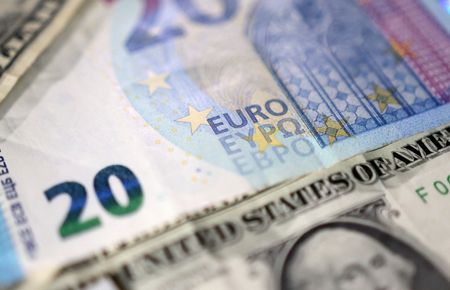By Rae Wee and Lucy Raitano
SINGAPORE & London (Reuters) -The euro hit a one-month low against the dollar on Tuesday as investors sobered up to the fact that terms of the trade deal between the U.S. and the European Union favoured the former and did little for the bloc’s economic outlook.
The common currency fell as much as 0.5% to its lowest level since June 23, adding to Monday’s steep decline. It last traded 0.17% lower at $1.1565.
France’s prime minister on Monday called the framework trade agreement a “dark day” for Europe, saying the bloc had caved in to U.S. President Donald Trump with an unbalanced deal that slapped a headline 15% tariff on EU goods.
German Chancellor Friedrich Merz said his economy would suffer “significant” damage due to the agreed tariffs.
The euro slid 1.3% in the previous session, its sharpest one-day percentage fall in more than two months, on worries about growth and as euro-area government bond yields fell.
“It hasn’t taken long for markets to conclude that this relatively good news is still, in absolute terms, bad news as far as the near-term implications for euro zone growth are concerned,” said Ray Attrill, head of FX research at National Australia Bank.
“The deal has been roundly condemned by France while others – including German Chancellor Merz – are playing up the negative consequences for exporters, and with that, economic growth.”
The slide in the euro in turn boosted the dollar, which jumped 1% against a basket of currencies overnight.
The dollar held on to its gains on Tuesday and knocked sterling to a two-month low of $1.3338. The yen edged 0.1% higher to 148.405 per dollar.
The dollar index firmed 0.2% to 98.811.
“While the U.S. dollar’s strength … may reflect the perception that the new U.S.-EU deal is lopsided in favour of the U.S., the U.S. dollar’s strength may also reflect a feeling that the U.S. is re-engaging with the EU and with its major allies,” said Thierry Wizman, global FX and rates strategist at Macquarie Group.
Trump said on Monday that most trading partners that do not negotiate separate trade deals would soon face tariffs of 15% to 20% on their exports to the United States, well above the broad 10% tariff he announced in April.
Elsewhere, the Australian dollar fell 0.18% to $0.65095, while the New Zealand dollar was off 0.24% at $0.59570.
The onshore yuan touched a one-week low of 7.1794 per dollar, with investors awaiting the outcome of trade talks between Washington and Beijing.
Top U.S. and Chinese economic officials met in Stockholm on Monday for more than five hours in a bid to resolve long-standing economic disputes at the centre of a trade war between the world’s top two economies, seeking to extend a truce by three months.
Apart from trade negotiations, investors’ focus this week is also on interest rate decisions from the Federal Reserve and the Bank of Japan (BOJ).
“Tomorrow’s Fed meeting should demonstrate that political pressure from the US government is gradually having an effect, with several interest rate cuts likely to follow starting in September. By then, the US dollar should also have started to weaken again”, wrote Commerzbank FX analysts in a note.
Both central banks are expected to stand pat on rates, but traders will watch subsequent comments to gauge the timing of their next moves.
Elsewhere, data on Tuesday showed Sweden’s gross domestic product grew by just 0.1% in the second quarter, undershooting most forecasts. The Swedish crown was down 0.33% against the dollar.
(Reporting by Rae Wee in Singapore and Lucy Raitano in London; Editing by Muralikumar Anantharaman, Kim Coghill and Hugh Lawson)









